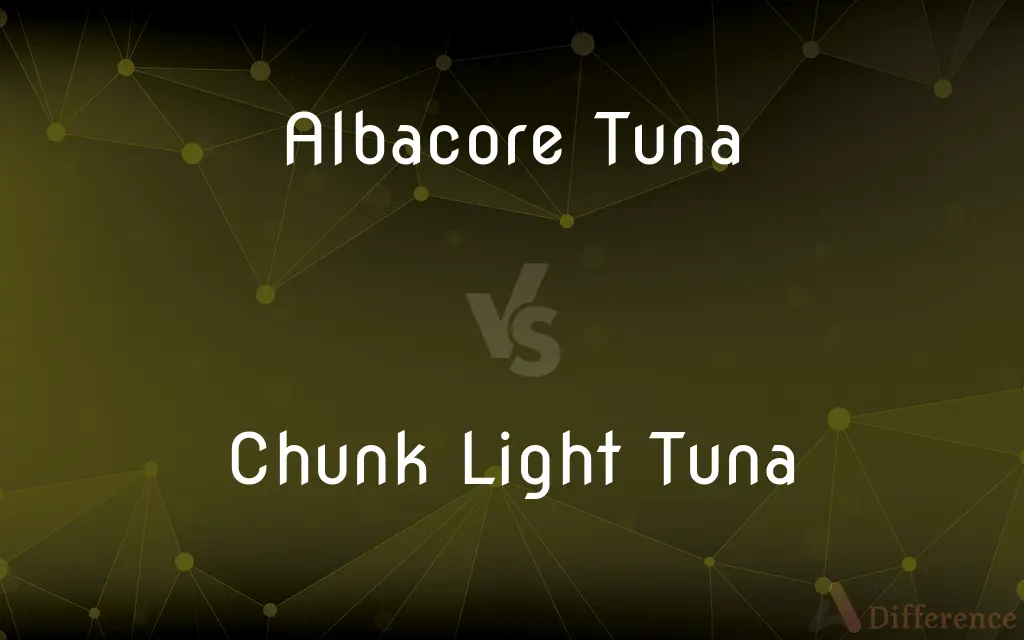Albacore Tuna vs. Chunk Light Tuna — What's the Difference?
By Maham Liaqat & Urooj Arif — Published on February 27, 2024
Albacore tuna, known for its lighter color and firmer texture, is a premium variety often sold as "white tuna," while chunk light tuna, typically a mix of smaller species, is darker and offers a stronger flavor.

Difference Between Albacore Tuna and Chunk Light Tuna
Table of Contents
ADVERTISEMENT
Key Differences
Albacore tuna stands out for its white to light pink flesh and is prized for its high-quality, mild flavor. It is often canned in larger pieces, sometimes labeled as "solid white," indicating that the can contains large chunks or even entire loins of fish. This variety is also higher in omega-3 fatty acids compared to other types of canned tuna, making it a healthier choice for those looking to increase their intake of these beneficial fats.
Chunk light tuna, on the other hand, is generally a blend of various smaller tuna species such as skipjack or yellowfin. It has a darker color, ranging from light pink to a brownish shade, and a more pronounced tuna flavor. The term "chunk" refers to the fact that the meat is broken into smaller pieces, which are then canned. This variety is more affordable and widely used in recipes where tuna is not the sole star, such as salads, sandwiches, and casseroles.
In terms of nutritional content, albacore tuna contains more omega-3 fatty acids but also has a higher mercury content due to its larger size and longer lifespan. This makes chunk light tuna a safer option for pregnant women and children, who are advised to limit their mercury intake.
The choice between albacore and chunk light tuna often comes down to personal preference, dietary considerations, and the intended use. Albacore's firmer texture and milder flavor make it suitable for dishes where the quality of the fish is paramount, while chunk light's stronger taste and lower cost make it versatile for everyday cooking.
Sustainability is another consideration, as some tuna fishing practices have been criticized for their environmental impact. Consumers are encouraged to look for certifications like the Marine Stewardship Council (MSC) label to ensure they are choosing brands that adhere to sustainable fishing practices.
ADVERTISEMENT
Comparison Chart
Color
White to light pink
Light pink to brownish
Texture
Firmer, sold as solid or chunk pieces
Softer, often broken into smaller chunks
Flavor
Milder, more delicate
Stronger, more pronounced tuna flavor
Omega-3 Fatty Acids
Higher content
Lower content
Mercury Content
Higher due to larger size and longer lifespan
Generally lower, safer for frequent consumption
Cost
More expensive, considered premium
More affordable, widely available
Preferred Use
High-quality presentations, salads, sandwiches
Cooking, casseroles, mixed dishes
Sustainability
Varied; dependent on fishing practices
Varied; dependent on species and practices
Compare with Definitions
Albacore Tuna
Known for its high omega-3 content.
He chose albacore tuna for its health benefits, especially the omega-3 fatty acids.
Chunk Light Tuna
Lower in mercury, suitable for more frequent consumption.
With its lower mercury levels, chunk light tuna was their go-to for weekly lunches.
Albacore Tuna
Often sold in solid or chunk form.
The recipe called for solid white albacore tuna to maintain the dish's premium quality.
Chunk Light Tuna
Commonly used in everyday dishes.
Chunk light tuna was the staple ingredient for their family's favorite tuna salad.
Albacore Tuna
Higher in mercury, requiring cautious consumption.
Due to its higher mercury content, they limited albacore tuna intake to once a week.
Chunk Light Tuna
Made from smaller tuna species, offering a stronger taste.
The casserole called for chunk light tuna for its intense flavor.
Albacore Tuna
A premium white tuna with a mild flavor.
She prepared a salad with albacore tuna for its light, delicate taste.
Chunk Light Tuna
A darker, more flavorful tuna blend.
She used chunk light tuna for the pasta sauce, appreciating its robust flavor.
Albacore Tuna
Preferred for its texture and taste in upscale dishes.
For the gourmet tuna melt, only albacore would do, for its superior texture.
Chunk Light Tuna
More affordable and versatile in cooking.
For budget-friendly meals, they stocked up on cans of chunk light tuna.
Common Curiosities
Can I substitute chunk light tuna for albacore in a recipe?
Yes, but expect a difference in flavor and texture. Albacore is milder and firmer, while chunk light is stronger in taste and softer.
How often can I safely eat albacore tuna?
Due to its higher mercury content, it's recommended to limit albacore tuna to about 3 servings per month for adults, with more restrictive guidelines for pregnant women and children.
Why is albacore tuna more expensive than chunk light tuna?
Albacore is considered a premium tuna due to its white flesh, mild flavor, and higher fat content, contributing to its higher price.
Is chunk light tuna always made from skipjack?
While skipjack is the most common, chunk light tuna can also include other smaller species like yellowfin, depending on the brand and source.
Is albacore or chunk light tuna better for you?
Both have health benefits; albacore is richer in omega-3s but higher in mercury, while chunk light is leaner and lower in mercury, making it safer for frequent consumption.
Are there sustainable options for both albacore and chunk light tuna?
Yes, look for certifications like MSC (Marine Stewardship Council) on the label to ensure you're buying tuna that's been sustainably fished.
How should I store canned tuna after opening?
Transfer any unused tuna to a sealed container and refrigerate for up to 2 days. Do not store it in the original can once opened.
Does the cooking method affect the omega-3 content in tuna?
Cooking methods can affect fat content slightly, but the omega-3 levels in tuna are relatively stable, making both raw and cooked tuna good sources of these fatty acids.
Can eating too much tuna be harmful?
Consuming too much of any tuna, especially varieties higher in mercury like albacore, can lead to mercury accumulation, which is why it's important to eat tuna in moderation.
Is there a difference in the canning process between albacore and chunk light tuna?
The basic canning process is similar, but albacore may be canned as solid or chunk white meat, while chunk light tuna is typically processed into smaller pieces.
Share Your Discovery

Previous Comparison
Tarot Cards vs. Oracle Cards
Next Comparison
Term Paper vs. ThesisAuthor Spotlight
Written by
Maham LiaqatCo-written by
Urooj ArifUrooj is a skilled content writer at Ask Difference, known for her exceptional ability to simplify complex topics into engaging and informative content. With a passion for research and a flair for clear, concise writing, she consistently delivers articles that resonate with our diverse audience.













































